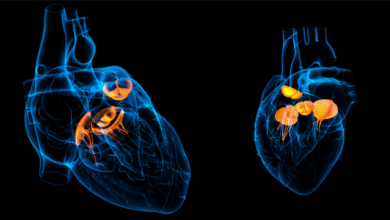Search results
Author(s):
Steven Zweibel
,
Melissa Trelfa
Added:
3 years ago
Continuous outpatient monitoring of a patient’s heart rhythm was initiated in 1949 with the invention of the Holter monitor by Norman J Holter. The early systems were bulky, recorded the heart’s rhythm for 24 or 48 hours onto a tape or cassette, and required that the data be analyzed by a technician after completion of the recording. As technology advanced, smaller devices (event recorders) were…
View more
Author(s):
Robert M Judd
,
Raymond J Kim
Added:
3 years ago
It is well known that major efforts are currently under way in the US, UK, and other countries to construct entirely new systems for the management of electronic medical records. The thesis of this article is that, in principle, it is possible to design these systems in such a manner that they serve not only as an information resource for routine patient care but simultaneously serve as the…
View more
Author(s):
William E Hellenbrand
Added:
3 years ago
Interventional Techniques to Treat Congenital Heart Disease
Congenital heart disease has been traditionally treated with surgery; however, with the development of interventional cardiology, patients are now benefiting from minimally invasive techniques.
Traditionally, open-heart surgery was performed to treat congenital stenoses and perform device closures for septal defects and other vascular…
View more
Author(s):
Gerald V Naccarelli
Added:
3 years ago
Atrial fibrillation (AF) continues to be the most common arrhythmic disorder that is admitted to the hospital in the Medicare population. Over the next five years, the worldwide AF market potential will grow to in excess of 8.5 million people. This growth is predominantly fueled by the aging of the worldwide population and the fact that AF is an affliction of the aged with up to 6% of…
View more
Author(s):
Denton A Cooley
Added:
3 years ago
Innovative technologies and refinements of existing therapies are shaping 21st century cardiovascular diagnosis and treatment. Researchers are gaining new perspectives on diseases and their treatment at the cellular and subcellular levels. Cardiologists are evaluating and treating coronary arteries by means of intravascular intervention. Surgeons are shortening recovery times and increasing cost…
View more
Author(s):
Daniel A Goor
,
Samuel Sclarovsky
Added:
3 years ago
According to Myerburg and Costellanos, the introduction of cardiac revascularization to medicine (coronary artery bypass grafting [CABG]) almost 50 years ago led to a decline in the age-adjusted mortality from coronary artery disease (CAD),1 but brought no change to the fraction of coronary deaths that are sudden and unexpected.1 Of the 650,000 who die annually in the US of CAD, 300,000–350,000…
View more
Added:
3 years ago
AHA Urges Action by New Congressional Leadership
The American Heart Association (AHA) in November urged the new congressional leadership to increase funding for cardiovascular disease research in order to help prevent a healthcare crisis emerging with the aging of the baby boomers.
With heart diseases and stroke affecting over 70 million adults in the US, rising levels of diabetes and obesity…
View more
Author(s):
Gerald V Naccarelli
,
Deborah L Wolbrette
,
Mazhar Khan
,
et al
Added:
3 years ago
Prospective trials have demonstrated that flecainide, propafenone, quinidine, and sotalol are equally effective in preventing recurrences of atrial fibrillation (AF). A new twice-a-day formulation of propafenone has been demonstrated to have efficacy that is higher than the short-acting form of the drug. Dofetilide, although useful for terminating and preventing recurrence of persistent AF, has…
View more
Author(s):
Peter J Fitzgerald
,
Martin B Leon
Added:
3 years ago
An unintended consequence of the market success of drug-eluting stents has been a growing concern about their safety and safety-related costs. These devices have been so quickly and widely adopted that their market penetration already equals that of some of the most popular pharmaceutical drugs. Consequently, the absolute significance of even a low incidence of side effects becomes magnified by…
View more
Author(s):
Peter J Fitzgerald
,
Martin B Leon
Added:
3 years ago
An unintended consequence of the market success of drug-eluting stents has been a growing concern about their safety and safety-related costs. These devices have been so quickly and widely adopted that their market penetration already equals that of some of the most popular pharmaceutical drugs. Consequently, the absolute significance of even a low incidence of side effects becomes magnified by…
View more










 « First
« First